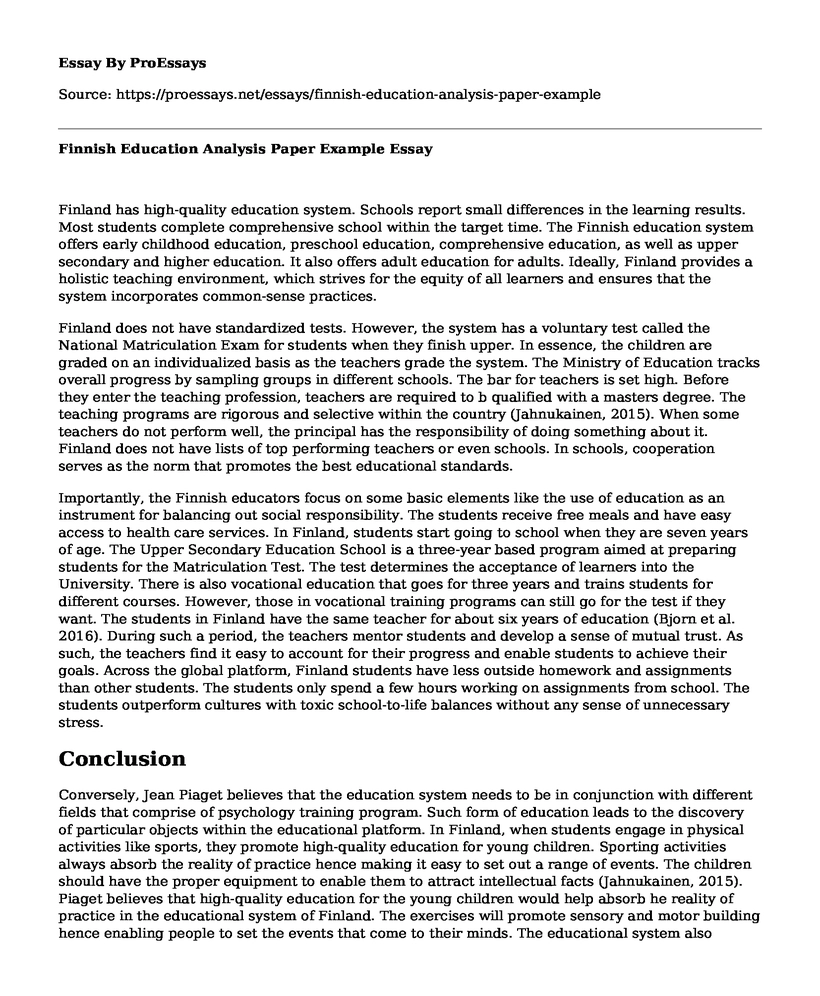Finland has high-quality education system. Schools report small differences in the learning results. Most students complete comprehensive school within the target time. The Finnish education system offers early childhood education, preschool education, comprehensive education, as well as upper secondary and higher education. It also offers adult education for adults. Ideally, Finland provides a holistic teaching environment, which strives for the equity of all learners and ensures that the system incorporates common-sense practices.
Finland does not have standardized tests. However, the system has a voluntary test called the National Matriculation Exam for students when they finish upper. In essence, the children are graded on an individualized basis as the teachers grade the system. The Ministry of Education tracks overall progress by sampling groups in different schools. The bar for teachers is set high. Before they enter the teaching profession, teachers are required to b qualified with a masters degree. The teaching programs are rigorous and selective within the country (Jahnukainen, 2015). When some teachers do not perform well, the principal has the responsibility of doing something about it. Finland does not have lists of top performing teachers or even schools. In schools, cooperation serves as the norm that promotes the best educational standards.
Importantly, the Finnish educators focus on some basic elements like the use of education as an instrument for balancing out social responsibility. The students receive free meals and have easy access to health care services. In Finland, students start going to school when they are seven years of age. The Upper Secondary Education School is a three-year based program aimed at preparing students for the Matriculation Test. The test determines the acceptance of learners into the University. There is also vocational education that goes for three years and trains students for different courses. However, those in vocational training programs can still go for the test if they want. The students in Finland have the same teacher for about six years of education (Bjorn et al. 2016). During such a period, the teachers mentor students and develop a sense of mutual trust. As such, the teachers find it easy to account for their progress and enable students to achieve their goals. Across the global platform, Finland students have less outside homework and assignments than other students. The students only spend a few hours working on assignments from school. The students outperform cultures with toxic school-to-life balances without any sense of unnecessary stress.
Conclusion
Conversely, Jean Piaget believes that the education system needs to be in conjunction with different fields that comprise of psychology training program. Such form of education leads to the discovery of particular objects within the educational platform. In Finland, when students engage in physical activities like sports, they promote high-quality education for young children. Sporting activities always absorb the reality of practice hence making it easy to set out a range of events. The children should have the proper equipment to enable them to attract intellectual facts (Jahnukainen, 2015). Piaget believes that high-quality education for the young children would help absorb he reality of practice in the educational system of Finland. The exercises will promote sensory and motor building hence enabling people to set the events that come to their minds. The educational system also provides materials that can be used to strengthen a range of educational activities.
References
Bjorn, P. M., Aro, M. T., Koponen, T. K., Fuchs, L. S., & Fuchs, D. H. (2016). The many faces of special education within RTI frameworks in the United States and Finland. Learning Disability Quarterly, 39(1), 58-66.
Jahnukainen, M. (2015). Inclusion, integration, or what? A comparative study of the school principals' perceptions of inclusive and special education in Finland and in Alberta, Canada. Disability & Society, 30(1), 59-72.
Cite this page
Finnish Education Analysis Paper Example. (2022, Sep 26). Retrieved from https://proessays.net/essays/finnish-education-analysis-paper-example
If you are the original author of this essay and no longer wish to have it published on the ProEssays website, please click below to request its removal:
- Nursing Scholarship Application Letter
- Be Aware About Anti-Bias for Preschool
- Observation Report: English Program for the International Staff Working at a University
- Children and Young People Are Protected Essay
- Essay Example on Houston ISD: A Leader in US Education Excellence
- Free Paper Sample on Advocating Change: Three Persuasive Speech Topics
- No Child Left Behind Legislation - Essay Sample







